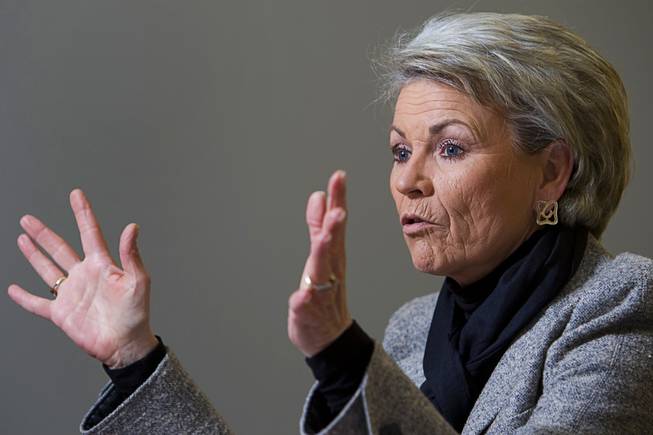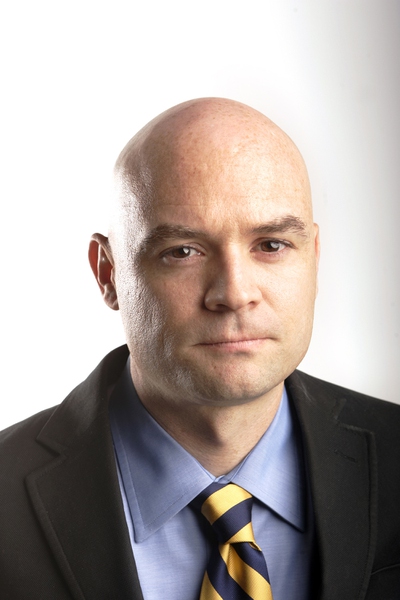
Pat Mulroy, general manager of the Southern Nevada Water Authority, is shown during an editorial board meeting at the Las Vegas Sun offices in Henderson, Jan. 18, 2012.
Tuesday, Feb. 28, 2012 | 1:02 p.m.
Sun archives
The Southern Nevada Water Authority announced last month that it would raise water rates because its financial model — a perpetual stream of new residents paying to build water infrastructure — has collapsed with the end of growth.
As I noted at the time , we were seeing the inevitable crumbling of a Ponzi scheme, and were dealt the startling realization that there’s no free lunch. Growth did not pay for growth.
Now, the water authority needs $260 million to cover a dramatic reduction in revenue from new connections to the water system. Now, the fight is about who will pay for that lunch we used to get for free.
Here, in a nutshell, is what they’ve proposed: The first plan would raise our bills based on usage — use more, pay more. This would hit big water users.
Hmmm. Which big property owners use lots of water? I can think of a few on Las Vegas Boulevard.
The second option is a flat fee that would mean a $5 monthly increase for most homeowners, but would pack a wallop for many small and medium-sized businesses. The Las Vegas Chamber of Commerce had the water authority’s financial experts pencil out increases, which at retailers and office complexes often exceed 100 percent.
A third plan would blend the first two.
The water authority wants to go with the second one, the flat fee, because it says credit markets prefer the stability of a flat-fee rate structure; when people get charged for the water they use, they often use less, meaning revenue at the water authority declines. This seems reasonable.
Also, however, large users, such as Strip operators, could take an enormous hit if they get charged more for the water they use, and the water authority likes having the Strip as an ally. So the Strip and homeowners — paying just $5 more per month — come out of this feeling pretty good because small and medium-sized businesses subsidize our cheap lunch.
See what’s going on here? The water authority, led by general manager and skilled political player Patricia Mulroy, has formed an unstoppable coalition to push the plan through the water authority board, which is made up of elected officials. The board will vote on the proposal Wednesday.
Who do elected officials listen to? All those homeowners — voters — who like their subsidized lunch, and the Strip, which funds political campaigns and pays an army of lobbyists, some of them former politicians.
When did I get so cynical? Maybe it’s from living here a few years.
When I asked the water authority about this, I first received a statement that said the agency was not recommending one option over the others and that the board of directors would make the decision. That was nonsense, which became all the more clear when I talked to Mulroy, who explained why option two, the flat rate, was preferable.
I asked about the objections of the small and medium-sized businesses. She said that for years they had been getting off easy because of an idiosyncrasy of the rate structure: As you use more you move to a higher pricing tier. But the bigger the pipe connecting to the water system, the more water you have to use to get moved into that more expensive tier. So if you build a bigger pipe, you save on your water bills.
Mulroy suggested this practice was rampant.
This is untrue, according to Michael Shohet, vice president of development for Territory Inc., which has 3 million square feet of shopping centers in the Las Vegas Valley. Tenants always pay utility costs, and the developer has no incentive to pay large upfront costs, including connection charges, for a bigger pipe to help tenants save on water bills. He estimated this is true for 80 to 90 percent of the commercial buildings in the valley.
Shohet said the price difference between a 1 1/2-inch water meter and a 2-inch meter is about $50,000. “On a project with multiple meters this could become a significant additional capital investment,” he wrote in a email.
The chamber also says they’re being gouged on fire lines. Mulroy’s response is that again, up until now, they’ve gotten a break: “Who should pay for fire lines? The businesses who own the fire line? Or should the rest of the community pay for commercial fire lines?”
She said 38 percent of all accounts are fire lines, though obviously with so few fires, this is not a significant cause of usage.
The chamber is supportive of the water infrastructure investments but wants residential customers to see their rates increase $10 instead of $5 to even out the pain. It also says the process for this rate hike has been a rigged game.
Major trade groups such as restaurants, retailers and commercial developers weren’t represented, they say.
Consider this: When NV Energy wanted to raise power rates last year, it was forced to endure a six-month slog during which the public and people like me examined the details and fought it.
Not so with the water authority. One minute, they’re saying they need money. The next thing you know, it’s on the board’s agenda for a vote in January. Thankfully, the board balked and asked for some public input.
What’s so grating to Mulroy’s new critics is that the water authority’s financial bind has been evident since 2008, when it was clear growth was finished, and there would be no new connection revenue from new residents and businesses.
Mulroy acknowledged the compressed timeline. She noted that if she proposed a rate hike years ago before exhausting financial reserves or completing all possible cost cutting, she would have been vilified, and she’s probably correct.
Still, why couldn’t this public process have begun last summer?
We might have used the time to have a discussion about how we — all of us — would start paying for the infrastructure required to have a stable water supply.
As for the delay, Mulroy said the financial analysis was hit with unexpected obstacles and took longer than she originally hoped. She said the chamber was asked for input in November.
Even with the $10 residential increase proposed by the chamber, our residential water rates would still be quite low — comparable to Phoenix, Scottsdale and Pasadena, according to data compiled by the chamber.
Mulroy acknowledged the extra pain levied on businesses but said this was the first step toward a more equitable rate structure, with the difference being made up by homeowners in the next round. She said forcing a $10 increase on them now is simply too much.
As Mulroy said, a mortgage payment is due, and the water board must act.
And, ultimately, responsibility for this mess lies with the water authority board. Our elected officials. Which really means we the voters are responsible. We loved having growth pay for everything when it was clear this was a foolish strategy. We liked our free lunch.


Join the Discussion:
Check this out for a full explanation of our conversion to the LiveFyre commenting system and instructions on how to sign up for an account.
Full comments policy